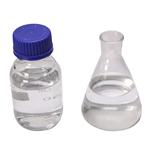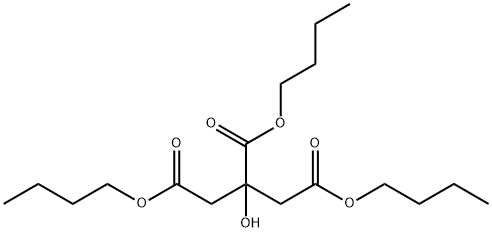- Tributyl citrate
-

- $10.00 / 1kg
-
2025-04-16
- CAS:77-94-1
- Min. Order: 1kg
- Purity: 99%
- Supply Ability: 100 mt
- Tributyl citrate
-

- $0.00 / 1KG
-
2025-04-15
- CAS:77-94-1
- Min. Order: 1KG
- Purity: 99%
- Supply Ability: 500000kg
- Tributyl Citrate
-

- $120.00 / 1kg
-
2025-04-15
- CAS:77-94-1
- Min. Order: 1kg
- Purity: 99%
- Supply Ability: 20ton
|
| Product Name: | Tributyl citrate | | Synonyms: | N-BUTYLCITRATE;TRIBUTYL CITRATE;TRIPHENYLBENZYLPHOSPHONIUM CHLORIDE;1,2,3-Propanetricarboxylic acid, 2-hydroxy-, tributyl ester;1,2,3-Propanetricarboxylicacid,2-hydroxy-,tributylester;2,3-propanetricarboxylicacid,2-hydroxy-tributylester;2-Hydroxy-1,2,3-propanetricarboxylic acid, tributyl ester;TributylCitrate99+% | | CAS: | 77-94-1 | | MF: | C18H32O7 | | MW: | 360.44 | | EINECS: | 201-071-2 | | Product Categories: | fine chemicals;Amino ester;Plasticizer;Hydroxycarboxylic Acid Esters (Plasticizer);Functional Materials;77-94-1;K00001 | | Mol File: | 77-94-1.mol |  |
| | Tributyl citrate Chemical Properties |
| Melting point | ≥300 °C(lit.) | | Boiling point | 234 °C (17 mmHg) | | density | 1.043 g/mL at 20 °C (lit.) | | Pour Point | -62 | | refractive index | n20/D 1.445 | | Fp | 300 °C | | storage temp. | Store below +30°C. | | solubility | Miscible with acetone, ethanol, and vegetable oil;
practically insoluble in water. | | pka | 11.30±0.29(Predicted) | | form | Liquid | | color | Clear | | Odor | odorless | | Water Solubility | insoluble | | Merck | 14,1564 | | BRN | 1806072 | | InChIKey | ZFOZVQLOBQUTQQ-UHFFFAOYSA-N | | LogP | 4.324 (est) | | CAS DataBase Reference | 77-94-1(CAS DataBase Reference) | | NIST Chemistry Reference | Butyl citrate(77-94-1) | | EPA Substance Registry System | 1,2,3-Propanetricarboxylic acid, 2-hydroxy-, tributyl ester (77-94-1) |
| Hazard Codes | T | | Risk Statements | 25 | | Safety Statements | 26-36/37/39-45-24/25 | | RIDADR | UN 2811 6.1/PG 2 | | WGK Germany | 3 | | RTECS | TZ8608000 | | TSCA | Yes | | HS Code | 29181500 |
| | Tributyl citrate Usage And Synthesis |
| Outline | Tributyl citrate (TBC) is a good environmental plasticizers, lubricants. At room temperature, it is non-toxic, it has fruit flavor, it is colorless oily liquid. Boiling point is 170℃ (133.3Pa), flash point (open cup) is 185℃. It is soluble in most organic solvents. Volatile is small, it has good compatibility with the resin, it has high efficiency in plastification, in Europe and other countries it is allowed for food packaging and medical products, as well as children's soft toys, pharmaceuticals, medical products, flavors and fragrances, cosmetics manufacturing and other industries.Products can be given a good cold resistance, water resistance and mildew resistance. The product which is resin plasticized can exhibit good transparency and low temperature flexural properties, and has low volatility and low extraction resistance in different media, thermal stability, it does not change color when be heat. The product which prepared by lubricating oil can have good lubricating properties.
| | New non-toxic plasticizer | The most commonly used plasticizer is phthalate esters industrially, because it can induce cancer, the use in foreign countries has been controlled strictly , China has also formulated relevant laws and regulations, and will phase out its use in food packaging materials, medical appliances toys . Tributyl citrate (TBC) is a new non-toxic plasticizer, because it has good compatibility, high plasticizing efficiency, non-toxic and less volatile, weather resistance and other characteristics of broad interest, it is used as the preferred alternative green products in place of phthalic dimethyl esters. With the growing awareness of environmental protection and improvement of environmental regulations, the development and production of tributyl citrate has excellent prospects.
Tributyl citrate is usually caused with citric acid and n-butanol in the presence of catalyst by esterifying, the conventional catalyst is concentrated sulfuric acid, although its low price, high catalytic activity, it can cause serious corrosion for equipment, post-processing process is complex, the select of reaction is poor, environmental pollution is serious and other defects, and thus the work of seeking alternative catalysts in place of concentrated sulfuric acid is very active, some better catalytic effect of the catalyst has been found:
[Sodium bisulfate catalytic synthesis of tributyl citrate]
Monohydrate Sodium hydroxide is a strong ionic compounds, the study found that it is soluble in water, aqueous solution is strongly acidic but it is insoluble in organic acids and alcohols reaction system, it can be used as a catalyst for esterification, studies show that the catalyst has a high activity catalytic, good stability, high yield, easy separation, convenient synthesis method, no corrosion, no pollution and other advantages.
[Synthesis of solid superacid catalyst]
Superacid is an acid, which the strength is greater than 100% sulfuric acid. Studies have shown that using it as a catalyst for the esterification reaction has good selectivity, fast response, high yield, easy separation, ease of operation, and the catalyst is stable, reusable, non-corrosive, non-polluting, it is a kind of promising catalyst.
[Synthesis of p-toluenesulfonic acid catalysis]
Toluenesulfonic acid is a strong organic acid, it can be used to instead of concentrated sulfuric acid as the esterification catalyst, and the corrosion for equipment and waste pollution is much smaller than that of sulfuric acid, it is also high activity and selectivity, cheap, dosage less, good product color, it is fit catalyst for industrial production.
[Miscellaneous catalytic synthesis of tributyl citrate]
Heteropolyacid is a multi-proton acid, the stronger of acidity, the more conducive to the formation of salt, it provide more favorable conditions for other nucleophilic attack, thus it speeds up the rate of the esterification reaction. It is non-volatile, the thermal stability is well, it also cause less pollution and can reduce equipment corrosion, it is an ideal esterification catalyst.
The above information is edited by the chemicalbook of Wang Xiaodong.
| | Chemical properties | It is colorless, oily liquid, slightly scented. It is insoluble in water, soluble in methanol, acetone, carbon tetrachloride, acetic acid, castor oil, mineral oil, organic solvents.
| | Uses | This product is innocuous plasticizer, it can be used for granulation of non-toxic PVC, it can be used for packaging materials in food production, soft toys for children, medical products, the plasticizer for polyvinyl chloride, vinyl chloride copolymers, cellulose resin.
| | Aroma | When absolutely pure, tributyl citrate has virtually no odor. However, a trace of Butanolodor is often perceptible.
Butyl citrate has found some - but very
little - use as a solvent/fixative in perfumes
and flavors. | | Chemical Properties | Colorless or pale-yellow, stable, odorless,
nonvolatile liquid. Practically
insoluble in water. Combustible. | | Chemical Properties | Tributyl citrate is a clear, odorless, practically colorless, oily liquid. | | Uses | Tributyl citrate can be used:
- To incorporate in zein film to enhance its mechanical properties for industrial processing.
- As a plasticizer to improve the ductile properties of poly(lactide) polymers.
| | Uses | Tributyl Citrate, is a non-phthalate plasticizer, that can be used for the preparation of resins. It can also used for the synthesis of Acetyl Tributyl Cirate, a valuable biodegradable plasticizer of low toxicity, found in nail polish and other cosmetics. | | Uses | Plasticizer and solvent for nitrocellulose lacquers; in polishes, inks and similar Preparations; also as anti-foam agent. | | Definition | ChEBI: Tributyl citrate is a carbonyl compound. | | Production Methods | Tributyl citrate is prepared by the esterification of citric acid with
butanol. | | General Description | Tributyl citrate is an ester of citric acid. It is used to plasticize polymers for coating solid drug dosage forms, tablets and capsules.
Certified pharmaceutical secondary standards for application in quality control provide pharma laboratories and manufacturers with a convenient and cost-effective alternative to pharmacopeia primary standards. | | Pharmaceutical Applications | Tributyl citrate is used to plasticize polymers in formulated
pharmaceutical coatings. The coating applications include capsules,
tablets, beads, and granules for taste masking, immediate release,
sustained-release, and enteric formulations. | | Safety | Tributyl citrate is used in oral pharmaceutical formulations. It is
generally regarded as an essentially nontoxic and nonirritating
material. However, ingestion of large quantities may be harmful.
LD50 (cat, oral): >50 mL/kg
LD50 (mouse, IP): 2.9 g/kg
LD50 (rat, oral): >30 mL/kg | | storage | Tributyl citrate should be stored in well-closed containers in a cool,
dry location at temperatures not exceeding 38℃. When stored in
accordance with these conditions, tributyl citrate is a stable
material. | | Incompatibilities | Tributyl citrate is incompatible with strong alkalis and oxidizing
materials. | | Regulatory Status | Approved in the USA for indirect food contact in food films.
Included in the Canadian List of Acceptable Non-medicinal
Ingredients. |
| | Tributyl citrate Preparation Products And Raw materials |
|